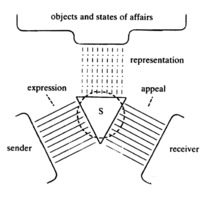-
Title
-
Organon Model of Language
-
Description
-
The circle in the middle symbolizes the concrete acoustic phenomenon. Three variable factors in it go to give it the rank of a sign in three different manners. The sides of the inscribed triangle symbolize these three factors. In one way the triangle encloses less than the circle (thus illustrating the principle of abstractive relevance). In another way it goes beyond the circle to indicate that what is given to the senses always receives an apperceptive complement. The parallel lines symbolize the semantic functions of the (complex) language sign. It is a symbol by vir tue of its coordination to objects and states of affairs, a symptom (Anzeichen, indicium: index) by virtue of its dependence on the sender, whose inner states it expresses, and a signal by virtue of its appeal to the hearer, whose inner or outer behaviour it directs as do other communicative signs. … What, then, do the parallel lines of the organon model symbolize? … [A]t this place in the diagram, there is, to put it in terms of modern mathematics, a coordination of sound signs to objects and states of affairs.
-
Designer
-
Bühler, Karl
-
Date
-
1934
-
Source
-
Theory of Language: The Representational Function of Language
-
Bibliographic Citation
-
Bühler, Karl. 2011. Theory of Language: The representational Function of Language. Translated by Donald Fraser Goodwin, in collaboration with Achim Eschbach. John Benjamins Publishing Company. Figure 3. Pages 34-36.
-
Bühler, Karl. 1934. Sprachtheorie. Gustav Fischer Verlag.
-
is composed of
-
English
Triangle
-
English
Circle
-
has attribute
-
English
Dash Line
-
English
Solid Line
-
depict things of type
-
English
Structural or Hierarchical
-
English
Conceptual
-
Coverage
-
communication
 Buhler-organon.png
Buhler-organon.png